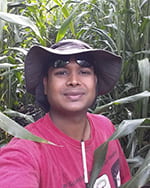Avinash Karn joined VitisGen2 in January 2018 as a postdoctoral research associate after completing his PhD at University of Missouri in Columbia, Missouri. Previously, he studied plant breeding, genetics and genomics at the University of Illinois as a postdoctoral research associate in 2017, where he investigated the genetics basis for maize root structure and control of plant nutrient relations in the “Illinois Protein Strain recombinant Inbred” (IPSRI) maize lines. Avi left VitisGen2 in December 31, 2020 to accept a new position as Molecular Breeding Discovery Scientist with AgReliant Genetics Research-Breeding Technology near Indianapolis, IN. The VitisGen2 team will miss Avi’s contributions, and wishes him and his family the best of luck in their next adventures.
 What got you interested in bioinformatics and genetics?
What got you interested in bioinformatics and genetics?
I am fascinated with the complexities in biology, and very intrigued by the high efficiency and accuracy of bioinformatics and statistical tools in data exploring, mining, manipulation and most importantly connecting genomic and phenotypic data.
While I was a graduate student, genotype-by-sequencing (GBS) had become one of the high areas of interest in the plant and animal breeding communities. I remember coming to Cornell University for the GBS workshop in 2013, where I realized that in coming years, one will require strong bioinformatics and statistical skills to tailor the plethora of genomic information to gain a holistic understanding of agronomically and economically important traits. I spent significant time gaining bioinformatics and statistical skills to utilize rapidly evolving state-of-the-art tools in precision phenotyping and genotyping to make rapid, accurate and affordable breeding decisions to improve human health, nutrition, and the environment for both developed and developing community.
How does your research fit in with the overall goals of the VitisGen2 project?
In the VitisGen2 project, I led genome-wide association and quantitative trait loci discovery projects, fine mapping of candidate genes, and developed amplicon sequencing genetic markers in collaboration with nation-wide grape breeders, pathologists, and computational biologists to leverage genetic and pedigree datasets for germplasm characterization, marker-assisted selection, marker-assisted introgression, and genomic selection and prediction.
In parallel, I worked with bioinformatics team to develop, prototype, and implement data pipeline and front-end applications that accelerated and increased the efficiency of grape breeding. These tasks included genotype-to-phenotype association studies, big data visualization, genetic maps curation; and genetic signal discovery studies applied to breeding programs. Moreover, I had been involved in managing grapevine breeding database www.VitisBase.org, in collaboration with Boyce Thompson Institute and the USDA Breeding Insight project.
What was the most challenging aspect of working with grapevine genetics?
Some of the most challenging aspect of working with grapevine genetics were:
- Parents of grapevine families are highly heterozygous and the progenies are usually F1, which makes it highly difficult to conduct fine mapping experiments and elucidate the genetic basis of any complex trait of interest.
- There is no experimental field design (randomization, replications, blocking) in grapevine breeding, limiting the accurate assessment of complex traits.
- Grapevine breeding families with small numbers of progeny (sample size) have limited statistical power to identify minor and interacting QTLs, which can be utilized to improve prediction of response to selections.
- High structural variations in grape genomes make it difficult in the assembly and annotation of the grape genomes.
- Grape breeding cycle takes 3 to 4 years to get from seed to seed, which makes it very challenging to validate marker-assisted selections and introgressions.
What is the most exciting thing you have learned or done while working on the VitisGen2 project?
One of the most exciting accomplishments I had while working on the VitisGen2 project was co-leading the development of collinear core genome rhAmpSeq haplotype molecular marker platform for the Vitis genus. It was exciting to see the platform produce high quality and consistent data, genetic maps and to follow the application of results in QTL discovery and marker assisted selection.
What tips would you give someone just joining the project (or just beginning a career in plant breeding)?
My suggestions to someone who is just joining the project would be:
- Learn about project objectives and have a clear understanding of one’s job responsibilities.
- Thoroughly read recent publications from the project.
- Meet and collaborate with other team members.
- Be versatile.
- Have a thorough documentation of every analyses you conduct and the results (be it an interesting finding or a failure).
- Keep a log entry of every tasks you perform such as QTL analyses, genetic maps, workshops etc.
- Keep your laptop and CBSU workstations organized.
- Lead the writing of manuscripts and push for publication.
